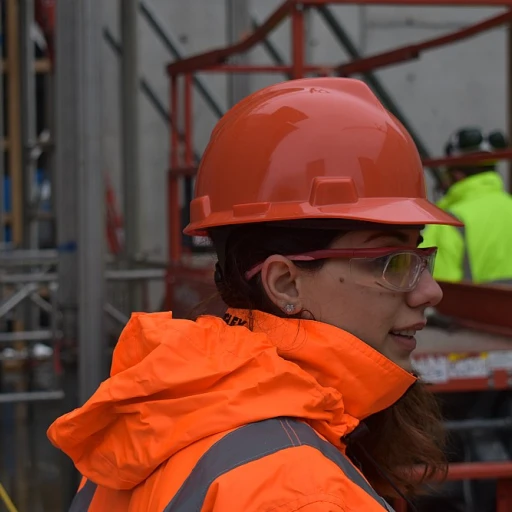
Understanding the shift in work-life balance expectations
Changing Priorities in the Modern Workforce
Over the past few years, the concept of work-life balance has evolved significantly. Employees and workers are no longer satisfied with simply separating work from personal life. Instead, there is a growing demand for a more integrated approach—what some call "work-life fit." This shift is influenced by a range of factors, including remote work trends, technological advancements, and changing attitudes toward mental health and well-being.
Organizations and leaders are noticing that employees want more than just traditional benefits. They seek flexibility, autonomy, and a sense of purpose in their job. Companies that respond to these expectations are seeing improvements in employee engagement, retention, and overall human capital management. The workforce now values time for personal growth, family, and health just as much as career advancement.
- Flexible work arrangements are becoming standard, not just a perk.
- Remote work and hybrid models allow employees to better balance work and life responsibilities.
- Mental health and well-being initiatives are now central to HR strategies.
- Skills-based management is helping companies adapt to the future of work.
These trends are not just about employee satisfaction—they are shaping the long-term success of organizations. As climate change, economic shifts, and artificial intelligence continue to impact the workplace, leaders must adapt their policies to support both business goals and employee well-being. For a deeper look at how these trends play out in specific industries, you can explore navigating work-life balance in market street careers.
Understanding these evolving expectations is essential for human resources professionals and management teams. It sets the stage for exploring how flexible work, technology, and well-being initiatives can be leveraged to create a more balanced and productive workforce.
Flexible work arrangements and their impact
Flexible Work: A New Standard for Modern Organizations
Flexible work arrangements have become a defining feature of today’s workforce. As organizations adapt to evolving employee expectations, the traditional nine-to-five job is giving way to more dynamic models. This shift is not just about remote work or hybrid schedules. It’s about empowering employees to balance work and personal life in ways that fit their unique needs and skills.
Companies are realizing that offering flexible work options is more than a perk—it’s a strategic move for attracting and retaining top talent. Workers increasingly value the ability to manage their own time, whether that means compressed workweeks, job sharing, or skills-based project assignments. These trends reflect a broader understanding that employee well-being and engagement are closely linked to life balance and personal autonomy.
- Remote work: Many employees now expect the option to work from home at least part of the time. This flexibility allows them to better integrate personal life responsibilities, from family care to pursuing new skills.
- Flexible hours: Allowing workers to choose when they start and end their day helps accommodate different life stages and personal commitments.
- Skills-based roles: Some organizations are moving away from rigid job descriptions, instead focusing on matching tasks to employee strengths and interests. This approach can boost engagement and long-term job satisfaction.
Human resources leaders are also exploring how flexible work can support mental health and employee well-being. When employees feel trusted to manage their own time, they’re more likely to report higher levels of job satisfaction and lower stress. This is especially important as companies navigate challenges like climate change, rapid technological change, and the growing importance of human capital management.
However, implementing flexible work arrangements isn’t without its challenges. Organizations must invest in management training, data-driven tools, and clear communication to ensure that both business goals and employee needs are met. The future work landscape will likely see even more emphasis on balance work and life fit, as leaders recognize the benefits for both employees and the organization as a whole.
For a deeper look at how companies are enhancing work-life balance through innovative solutions, check out this article on personalized modular workstations.
Mental health and well-being initiatives
Prioritizing Employee Well-Being in Today’s Workforce
The conversation around work-life balance has evolved, with mental health and well-being now central to how organizations support their employees. As flexible work and remote work become more common, companies are recognizing that employee well-being is not just a benefit, but a necessity for long-term success and employee engagement. Many organizations are investing in mental health initiatives, offering resources like counseling, stress management workshops, and skills-based training to help employees balance work and personal life. These efforts are designed to help workers manage job demands while maintaining their personal life fit, especially as the boundaries between work and home blur in remote work settings.- Flexible work arrangements can reduce stress and improve employee well-being, but only if leaders actively support these policies and ensure workloads remain manageable.
- Companies are increasingly using data-driven approaches to measure the impact of well-being programs, allowing human resources teams to adapt strategies for different segments of the workforce.
- Employee engagement rises when workers feel their mental health is valued, leading to better retention and a stronger human capital base for organizations.
Technology’s role in supporting work-life balance
Digital Tools Shaping the Modern Workday
Technology is now at the heart of how organizations approach work-life balance. With the rise of remote work and flexible work arrangements, digital platforms have become essential for both employees and leaders. Video conferencing, project management apps, and instant messaging tools allow workers to collaborate from anywhere, making it easier to fit work around personal life commitments. This shift is especially relevant for companies aiming to attract and retain a diverse workforce with varying needs and skills.
Artificial Intelligence and Data-Driven Management
Artificial intelligence (AI) and data-driven solutions are transforming how human resources teams manage employee engagement and well-being. AI-powered scheduling tools help balance work demands with employee preferences, while analytics platforms track trends in job satisfaction and productivity. These insights enable organizations to design benefits and policies that support both employee well-being and long-term business goals. As a result, employees feel more valued and empowered to manage their time effectively.
Supporting Employee Well-Being Through Technology
Many companies are investing in digital health and wellness programs to support mental health and work-life fit. Online counseling, mindfulness apps, and virtual fitness classes are now common benefits that help employees manage stress and maintain a healthy balance between work and personal life. These initiatives not only improve employee well-being but also contribute to a positive organizational climate and stronger human capital.
Challenges and Skills for the Future
While technology offers many benefits, it also presents challenges. The constant connectivity can blur boundaries between work and personal time, making it harder for workers to disconnect. Leaders and human resources professionals need to develop new management skills to set clear expectations and encourage healthy digital habits. As the future of work evolves, organizations must continue to adapt their strategies to ensure that technology supports, rather than hinders, true work-life balance.
Challenges in implementing work-life balance strategies
Barriers to Achieving True Balance
Even as organizations recognize the importance of work-life balance, putting effective strategies into practice is not always straightforward. Many companies face ongoing challenges that can slow progress or create new obstacles for both employees and leaders.
- Resistance to Change: Some leaders and managers are still adapting to the evolving expectations of the workforce. Traditional views on productivity and job performance can clash with flexible work or remote work models, making it difficult to implement new policies.
- Technology Overload: While digital tools and artificial intelligence can help manage tasks and support remote work, they also blur the boundaries between work and personal life. Employees often feel pressure to be available outside of regular hours, which can impact mental health and employee well-being.
- Skills Gaps and Training: As companies shift toward skills-based management and data-driven approaches, not all workers have the necessary skills or resources to adapt. This can affect employee engagement and the ability to balance work and life effectively.
- Equity and Inclusion: Flexible work arrangements may not be equally accessible to all employees. Some roles require on-site presence, while others can be performed remotely. Organizations need to ensure that benefits and opportunities are distributed fairly across the workforce.
- Measuring Impact: Human resources teams often struggle to track the long-term benefits of work-life balance initiatives. Without clear data, it is challenging to demonstrate the value of these programs or adapt them to changing trends.
Organizational Culture and Leadership
Company culture plays a significant role in how well work-life balance strategies are adopted. Leaders who prioritize human capital and employee well-being help create an environment where workers feel supported in managing their time and personal life. However, shifting organizational culture requires ongoing commitment and clear communication from top management.
External Pressures and Uncertainty
Factors like climate change, economic shifts, and the rapid pace of technological change add complexity to the work-life equation. Organizations must remain agile and responsive to these external pressures, ensuring that their policies continue to meet the needs of a diverse and evolving workforce.
Measuring success and adapting policies
Tracking Progress with Data-Driven Approaches
Organizations today are increasingly using data-driven methods to measure the effectiveness of their work-life balance strategies. By collecting feedback from employees and monitoring key indicators like employee engagement, job satisfaction, and turnover rates, leaders can assess whether their initiatives are truly making a difference. Regular surveys, pulse checks, and even anonymous suggestion boxes help companies understand how workers feel about their work personal life fit and whether flexible work arrangements are supporting their needs.Key Metrics for Success
Some of the most common metrics used to evaluate work-life balance efforts include:- Employee well-being scores and mental health indicators
- Absenteeism and presenteeism rates
- Retention and turnover statistics
- Utilization rates of flexible work and remote work options
- Feedback on management support and skills-based leadership












